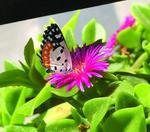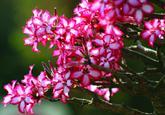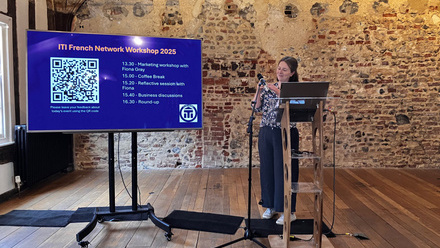Flowering talent
Written by Pavitra Baxi
Pavitra Baxi had given up on gardening till a new translation opportunity came along, bringing with it new growth in both personal and professional lives.
A lush green garden was a constant feature of my childhood. I grew up in Baroda, Gujarat (in the west of India), where you’ll commonly find bougainvillea, cactuses and nightblooming jasmines all growing. My parents are avid gardeners, and if there was a new variety of plant on the market, it would come home in no time. Their prized possession is an impala lily plant, which is now 24 years old and still thriving. Seeing how effortlessly plants grew made me believe that gardening was easy, and I just had to bring a plant home, water it, feed it with compost and watch it grow.

Working on a gardening translation project made it possible to go back to the garden too.
These days I live in Bengaluru, in the south, which has fabulous weather for flowering plants. Wanting to follow in my parents’ footsteps, I embarked on a gardening adventure a few years back that sadly ended with a series of horticultural disappointments. My first plant was a beautiful Chinese evergreen called ‘Firecracker’; its large red-and-white speckled leaves and its appealing low-maintenance tag made it an ideal beginner’s plant. Or so you’d think…but I placed it in a dark corner of the house and overwatered it to death. Next to bear the brunt of my ineptitude were two lush green pots of spider plants, supposedly easy to care for; I lost both of them in less than a month.
I put the brakes on my gardening ambition and settled for a largely plantless life. But things were about to change for the better, thanks to my profession. An agency I regularly worked with wanted me to be part of a long-term gardening website translation project. I would be working along with four other translators. An enthusiastic bunch, we not only exchanged notes relating to the project but also shared our gardening travails and successes.
Naming the plants
The website was to be translated and localised for the US readership. The first few weeks of the project saw intense discussions on project planning and preparing project guidelines: we compiled a list of websites, prepared a glossary of frequently used terms, and had lengthy discussions on the common names of the plants. This was by far the most enjoyable, albeit rather challenging, part of the project. Common names of plants are usually region-specific and tricky to translate. Much like idioms, they are hard to get a word-by-word match for in the target language. For instance, the orchid species has a whole range of whimsical names such as ‘dancing orchid’, ‘nun’s hood orchid’, or ‘lady’s slipper orchid’.
The language of gardening
Wading my way through the puzzling waters of plant terminology, I found out that most of what we plant in our gardens are hybrids: a cross between two varieties of a plant species. These are typically sturdier than the naturally occurring variety and can withstand environmental stresses. Then there are cultivars, selectively bred plants, which are subsequently propagated through plant cuttings. A plant is an heirloom if its seeds have been passed on for generations and its characteristics are the same as those of the parent plant.

My work was not limited to beautiful flowers and bountiful trees. I got to know the dark side of plant breeding too: the smuggling of wild orchids from their natural habitat. Orchids seem to be a gardener’s favourite and came up fairly frequently in the project. Although they are one of the most prolific plant species in nature, they are challenging to breed artificially. As they are native to the tropics, growing them in cold climates requires carefully monitored soil, temperature and humidity conditions. The smuggling trade in this area is not well known but is rampant nonetheless. The fragile forest ecosystem has already been disturbed by our economic activities, and to add to that, the rampant smuggling has brought several species to the brink of extinction. And in any case these wild species have special growing needs, so they often don’t adapt well to the new area where they have been planted.
New room for growth
Once the project was over, I decided to give gardening one more chance. But this time around, I did things differently. Taking into account the limitations of my busy schedule, I picked up local, sturdy hybrids of flowering plants and applied a more intuitive approach to watering and fertilising them. I paid more attention to their soil, sunlight and shade requirements and relied heavily on patience and perseverance. The result has been satisfactory, and I have a tiny thriving terrace garden. What’s more, my parents have placed enough trust in me to take care of the six-year-old offspring of their prized, long-lived impala lily plant.
But because we worked in a team and had a lot of discussions about the tone, register and style, the end product doesn’t sound like a patchwork of translations. The collective intelligence produced by teamwork can be extremely efficient, highly productive and undoubtedly a very elegant way of working.
Translation is more than just a career; with the right intention and motivation it can be a profitable learning platform. With every new project I don’t just earn a livelihood but also upgrade my life skills. My garden is growing, and so am I.
This article appeared as the cover article in the March-April 2021 edition of the ITI Bulletin.
About the writer

Pavitra Baxi is a German to English translator based in Bengaluru, India. She works mainly in the engineering, medical and IT sectors. She is a mechanical engineer by qualification, and developed software solutions for the automobile and construction engineering sectors before turning to full-time translation. Her website is www.pavitrabaxi.com, and you can contact her at [email protected].
Never miss another Bulletin article

If you would like to read more features and articles on a wide variety of subjects relating to all aspects of the translation and interpreting industry, subscribe to ITI Bulletin. Alternatively, join ITI and get a free subscription included in your membership.






